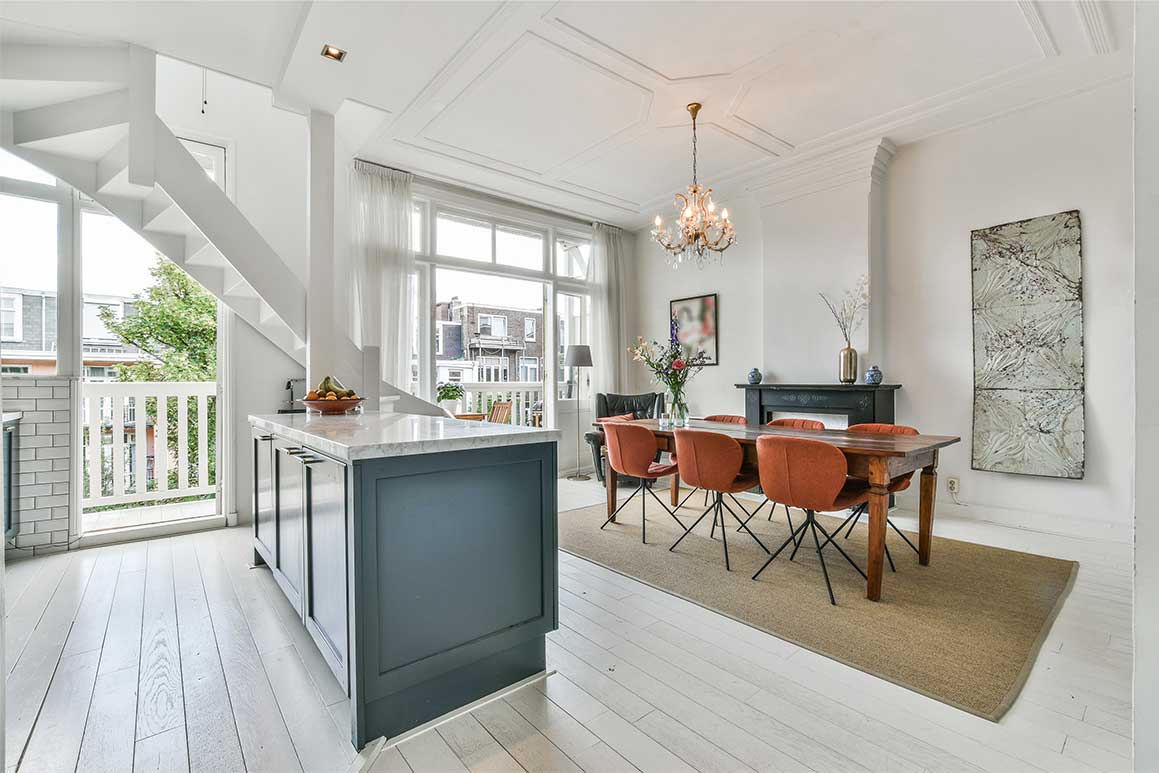 Image source
There’s no denying that San Diego is one of the most beautiful destinations to live. With near perfect weather year-round, great schools, an amazing culture, and picture-perfect beaches, there’s nothing not to love. And although the city has been historically known for sky-high prices, the current market has reached something of a homeostasis state, ideal for buyers and sellers and offering pros for both. Buyers are in a particularly good position. Simply put, this is a great time for investors to focus their efforts on this sun-soaked city.
And why’s that? For starters, people are migrating to the city in droves—particularly millenials looking for a place to settle down and achieve the ideal work-life balance. Since 2010, San Diego’s population rate has grown by 7.5%, proving that the city is ripe with people looking to move here. Additionally, 160,000 jobs have been added since the same year.
And it’s not just about the wealth of people turning to San Diego for a myriad of reasons. Though real estate prices will rise slightly, this will happen at a much slower rate than it has in the past. According to current data, home prices are expected to continue to fall slightly until around 2021. And yet, the annual home appreciation rate in San Diego is 4.5%—one of the strongest in the country, offering yet another reason to feel confident you’ve made a good investment.
And lastly, the short term rental market is ripe with opportunity: from 2016 to 2017, the short term rental industry saw growth of 15.9%. With so much to do and see in San Diego, it’s became one of the top vacation destinations. Simply put, San Diego is the best place to invest in California.
If you’re convinced, we’d like to offer you some tips that can help guide you through the buying process.
Always Do Your Due Diligence
Regardless of the investment type, it’s always important to do your due diligence. Early research will help you make smart decisions about your investment. For instance, you’ll want to analyze each San Diego neighborhood to see where your investment most makes sense. Just because a particular neighborhood is popular doesn’t mean you should jump on it: every neighborhood offers something different at different price points. You also want to look at the neighborhood stats to see what areas are seeing growth, and examine data to look for future trends. And lastly, you should have a thorough understanding of how San Diego mortgage rates will affect your budget.
Know Your Goals
As you well know, there are different types of investments you can make into properties. If your goal to be a landlord for a single family, manage vacation rentals, or manage multiple units? Understanding your goals can help you better focus your research efforts. For example, if your goal is to spearhead a collection of vacation rental properties, than you should know which neighborhoods are most popular on short term rental sites like Airbnb. Pacific Beach has an average cash on cash return on Airbnb of 3.33%, compared to Hillcrest’s 2.5%.
Set the Price Right
Choosing the right price for your property could make or break your ability to rent it, regardless of what type of investment property you have. Contrary to what you might think, it’s very possible to price your home too high or too low. High prices alienate potential willing customers looking for an affordable vacation, and prices that are too low can easily start to feel “too good to be true,” potentially infusing the idea that something must be wrong. Short term rental sites help you determine a price based on your location and what similar properties in the area are going for. Ideally, you’ll set your price slightly lower the competition to generate more bookings and potential renters.
Choose a Strategy
Part of understanding your goals means choosing a strategy that aligns with them. For instance, one strategy might be flipping a house. If you have the expertise and funds to do so, you could purchase a much cheaper property and flip it into something rentable. Although this a more difficult route, you could make a decent profit selling or renting. With a “buy and hold” strategy, you’re investing in the short or long term vacation rental space.
In this case, you have to consider how you’ll want to manage those properties. You could do it yourself, which requires plenty of hands-on work, or hire a property management company who will find and manage tenants for a percentage of the rental income. Each of these are viable options. Ideally, no matter what you choose, you should be making a 5% annual return on your investment at the very least. And in the long term, your property value should increase.
Think About Your Expenses
Understanding and being realistic is key to making efficient moves. When you invest in a rental property, chances are you aren’t going to turn a profit right away, and this is something you’ll need to consider as you go through the motions of making a final investment decision. If you don’t plan on managing the property yourself, you’ll have to consider management fees on top of everything else. Homeowners insurance, maintenance, and landlord insurance are other expenses to keep in mind. And if you intend to use the home yourself for a portion of the year, you should also consider how that will affect your returns.
Part of being smart about your financial situation means knowing when to make an investment move, too. If you have slews of personal debt, you might want to pay a chunk of that debt down before you jump into another serious financial commitment. You’ll also have to consider that investment properties require a larger down payment than traditional family homes. Expect to put down around 20% of the property value.
Consider Worse Case Scenarios
No matter what type of investment you make, it’s important to consider worse case scenarios. For example, at some point in San Diego, a legislation was passed to forbid homeowners from renting out their properties as vacation rentals. Though the legislation has since been revoked, it’s something to consider—having a backup plan and understanding local laws and loopholes will put you in a much better position.
Another worse case scenario is low vacancy. Low vacancies are a nightmare for any investor, as this really affects your bottom line. Lowering the rent is one way to combat this, but marketing your property the right way is another solution. For instance, you might offer extra incentives to make your property appear even more appealing—like free parking, utilities, or transportation passes. If you have a multi-unit rental, you’ll benefit from having other renters while you look to fill a vacancy.
Image source
There’s no denying that San Diego is one of the most beautiful destinations to live. With near perfect weather year-round, great schools, an amazing culture, and picture-perfect beaches, there’s nothing not to love. And although the city has been historically known for sky-high prices, the current market has reached something of a homeostasis state, ideal for buyers and sellers and offering pros for both. Buyers are in a particularly good position. Simply put, this is a great time for investors to focus their efforts on this sun-soaked city.
And why’s that? For starters, people are migrating to the city in droves—particularly millenials looking for a place to settle down and achieve the ideal work-life balance. Since 2010, San Diego’s population rate has grown by 7.5%, proving that the city is ripe with people looking to move here. Additionally, 160,000 jobs have been added since the same year.
And it’s not just about the wealth of people turning to San Diego for a myriad of reasons. Though real estate prices will rise slightly, this will happen at a much slower rate than it has in the past. According to current data, home prices are expected to continue to fall slightly until around 2021. And yet, the annual home appreciation rate in San Diego is 4.5%—one of the strongest in the country, offering yet another reason to feel confident you’ve made a good investment.
And lastly, the short term rental market is ripe with opportunity: from 2016 to 2017, the short term rental industry saw growth of 15.9%. With so much to do and see in San Diego, it’s became one of the top vacation destinations. Simply put, San Diego is the best place to invest in California.
If you’re convinced, we’d like to offer you some tips that can help guide you through the buying process.
Always Do Your Due Diligence
Regardless of the investment type, it’s always important to do your due diligence. Early research will help you make smart decisions about your investment. For instance, you’ll want to analyze each San Diego neighborhood to see where your investment most makes sense. Just because a particular neighborhood is popular doesn’t mean you should jump on it: every neighborhood offers something different at different price points. You also want to look at the neighborhood stats to see what areas are seeing growth, and examine data to look for future trends. And lastly, you should have a thorough understanding of how San Diego mortgage rates will affect your budget.
Know Your Goals
As you well know, there are different types of investments you can make into properties. If your goal to be a landlord for a single family, manage vacation rentals, or manage multiple units? Understanding your goals can help you better focus your research efforts. For example, if your goal is to spearhead a collection of vacation rental properties, than you should know which neighborhoods are most popular on short term rental sites like Airbnb. Pacific Beach has an average cash on cash return on Airbnb of 3.33%, compared to Hillcrest’s 2.5%.
Set the Price Right
Choosing the right price for your property could make or break your ability to rent it, regardless of what type of investment property you have. Contrary to what you might think, it’s very possible to price your home too high or too low. High prices alienate potential willing customers looking for an affordable vacation, and prices that are too low can easily start to feel “too good to be true,” potentially infusing the idea that something must be wrong. Short term rental sites help you determine a price based on your location and what similar properties in the area are going for. Ideally, you’ll set your price slightly lower the competition to generate more bookings and potential renters.
Choose a Strategy
Part of understanding your goals means choosing a strategy that aligns with them. For instance, one strategy might be flipping a house. If you have the expertise and funds to do so, you could purchase a much cheaper property and flip it into something rentable. Although this a more difficult route, you could make a decent profit selling or renting. With a “buy and hold” strategy, you’re investing in the short or long term vacation rental space.
In this case, you have to consider how you’ll want to manage those properties. You could do it yourself, which requires plenty of hands-on work, or hire a property management company who will find and manage tenants for a percentage of the rental income. Each of these are viable options. Ideally, no matter what you choose, you should be making a 5% annual return on your investment at the very least. And in the long term, your property value should increase.
Think About Your Expenses
Understanding and being realistic is key to making efficient moves. When you invest in a rental property, chances are you aren’t going to turn a profit right away, and this is something you’ll need to consider as you go through the motions of making a final investment decision. If you don’t plan on managing the property yourself, you’ll have to consider management fees on top of everything else. Homeowners insurance, maintenance, and landlord insurance are other expenses to keep in mind. And if you intend to use the home yourself for a portion of the year, you should also consider how that will affect your returns.
Part of being smart about your financial situation means knowing when to make an investment move, too. If you have slews of personal debt, you might want to pay a chunk of that debt down before you jump into another serious financial commitment. You’ll also have to consider that investment properties require a larger down payment than traditional family homes. Expect to put down around 20% of the property value.
Consider Worse Case Scenarios
No matter what type of investment you make, it’s important to consider worse case scenarios. For example, at some point in San Diego, a legislation was passed to forbid homeowners from renting out their properties as vacation rentals. Though the legislation has since been revoked, it’s something to consider—having a backup plan and understanding local laws and loopholes will put you in a much better position.
Another worse case scenario is low vacancy. Low vacancies are a nightmare for any investor, as this really affects your bottom line. Lowering the rent is one way to combat this, but marketing your property the right way is another solution. For instance, you might offer extra incentives to make your property appear even more appealing—like free parking, utilities, or transportation passes. If you have a multi-unit rental, you’ll benefit from having other renters while you look to fill a vacancy.

Tips for buying a rental property in San Diego
By Mclain Properties Tuesday, July 16, 2019
 Image source
There’s no denying that San Diego is one of the most beautiful destinations to live. With near perfect weather year-round, great schools, an amazing culture, and picture-perfect beaches, there’s nothing not to love. And although the city has been historically known for sky-high prices, the current market has reached something of a homeostasis state, ideal for buyers and sellers and offering pros for both. Buyers are in a particularly good position. Simply put, this is a great time for investors to focus their efforts on this sun-soaked city.
And why’s that? For starters, people are migrating to the city in droves—particularly millenials looking for a place to settle down and achieve the ideal work-life balance. Since 2010, San Diego’s population rate has grown by 7.5%, proving that the city is ripe with people looking to move here. Additionally, 160,000 jobs have been added since the same year.
And it’s not just about the wealth of people turning to San Diego for a myriad of reasons. Though real estate prices will rise slightly, this will happen at a much slower rate than it has in the past. According to current data, home prices are expected to continue to fall slightly until around 2021. And yet, the annual home appreciation rate in San Diego is 4.5%—one of the strongest in the country, offering yet another reason to feel confident you’ve made a good investment.
And lastly, the short term rental market is ripe with opportunity: from 2016 to 2017, the short term rental industry saw growth of 15.9%. With so much to do and see in San Diego, it’s became one of the top vacation destinations. Simply put, San Diego is the best place to invest in California.
If you’re convinced, we’d like to offer you some tips that can help guide you through the buying process.
Always Do Your Due Diligence
Regardless of the investment type, it’s always important to do your due diligence. Early research will help you make smart decisions about your investment. For instance, you’ll want to analyze each San Diego neighborhood to see where your investment most makes sense. Just because a particular neighborhood is popular doesn’t mean you should jump on it: every neighborhood offers something different at different price points. You also want to look at the neighborhood stats to see what areas are seeing growth, and examine data to look for future trends. And lastly, you should have a thorough understanding of how San Diego mortgage rates will affect your budget.
Know Your Goals
As you well know, there are different types of investments you can make into properties. If your goal to be a landlord for a single family, manage vacation rentals, or manage multiple units? Understanding your goals can help you better focus your research efforts. For example, if your goal is to spearhead a collection of vacation rental properties, than you should know which neighborhoods are most popular on short term rental sites like Airbnb. Pacific Beach has an average cash on cash return on Airbnb of 3.33%, compared to Hillcrest’s 2.5%.
Set the Price Right
Choosing the right price for your property could make or break your ability to rent it, regardless of what type of investment property you have. Contrary to what you might think, it’s very possible to price your home too high or too low. High prices alienate potential willing customers looking for an affordable vacation, and prices that are too low can easily start to feel “too good to be true,” potentially infusing the idea that something must be wrong. Short term rental sites help you determine a price based on your location and what similar properties in the area are going for. Ideally, you’ll set your price slightly lower the competition to generate more bookings and potential renters.
Choose a Strategy
Part of understanding your goals means choosing a strategy that aligns with them. For instance, one strategy might be flipping a house. If you have the expertise and funds to do so, you could purchase a much cheaper property and flip it into something rentable. Although this a more difficult route, you could make a decent profit selling or renting. With a “buy and hold” strategy, you’re investing in the short or long term vacation rental space.
In this case, you have to consider how you’ll want to manage those properties. You could do it yourself, which requires plenty of hands-on work, or hire a property management company who will find and manage tenants for a percentage of the rental income. Each of these are viable options. Ideally, no matter what you choose, you should be making a 5% annual return on your investment at the very least. And in the long term, your property value should increase.
Think About Your Expenses
Understanding and being realistic is key to making efficient moves. When you invest in a rental property, chances are you aren’t going to turn a profit right away, and this is something you’ll need to consider as you go through the motions of making a final investment decision. If you don’t plan on managing the property yourself, you’ll have to consider management fees on top of everything else. Homeowners insurance, maintenance, and landlord insurance are other expenses to keep in mind. And if you intend to use the home yourself for a portion of the year, you should also consider how that will affect your returns.
Part of being smart about your financial situation means knowing when to make an investment move, too. If you have slews of personal debt, you might want to pay a chunk of that debt down before you jump into another serious financial commitment. You’ll also have to consider that investment properties require a larger down payment than traditional family homes. Expect to put down around 20% of the property value.
Consider Worse Case Scenarios
No matter what type of investment you make, it’s important to consider worse case scenarios. For example, at some point in San Diego, a legislation was passed to forbid homeowners from renting out their properties as vacation rentals. Though the legislation has since been revoked, it’s something to consider—having a backup plan and understanding local laws and loopholes will put you in a much better position.
Another worse case scenario is low vacancy. Low vacancies are a nightmare for any investor, as this really affects your bottom line. Lowering the rent is one way to combat this, but marketing your property the right way is another solution. For instance, you might offer extra incentives to make your property appear even more appealing—like free parking, utilities, or transportation passes. If you have a multi-unit rental, you’ll benefit from having other renters while you look to fill a vacancy.
Image source
There’s no denying that San Diego is one of the most beautiful destinations to live. With near perfect weather year-round, great schools, an amazing culture, and picture-perfect beaches, there’s nothing not to love. And although the city has been historically known for sky-high prices, the current market has reached something of a homeostasis state, ideal for buyers and sellers and offering pros for both. Buyers are in a particularly good position. Simply put, this is a great time for investors to focus their efforts on this sun-soaked city.
And why’s that? For starters, people are migrating to the city in droves—particularly millenials looking for a place to settle down and achieve the ideal work-life balance. Since 2010, San Diego’s population rate has grown by 7.5%, proving that the city is ripe with people looking to move here. Additionally, 160,000 jobs have been added since the same year.
And it’s not just about the wealth of people turning to San Diego for a myriad of reasons. Though real estate prices will rise slightly, this will happen at a much slower rate than it has in the past. According to current data, home prices are expected to continue to fall slightly until around 2021. And yet, the annual home appreciation rate in San Diego is 4.5%—one of the strongest in the country, offering yet another reason to feel confident you’ve made a good investment.
And lastly, the short term rental market is ripe with opportunity: from 2016 to 2017, the short term rental industry saw growth of 15.9%. With so much to do and see in San Diego, it’s became one of the top vacation destinations. Simply put, San Diego is the best place to invest in California.
If you’re convinced, we’d like to offer you some tips that can help guide you through the buying process.
Always Do Your Due Diligence
Regardless of the investment type, it’s always important to do your due diligence. Early research will help you make smart decisions about your investment. For instance, you’ll want to analyze each San Diego neighborhood to see where your investment most makes sense. Just because a particular neighborhood is popular doesn’t mean you should jump on it: every neighborhood offers something different at different price points. You also want to look at the neighborhood stats to see what areas are seeing growth, and examine data to look for future trends. And lastly, you should have a thorough understanding of how San Diego mortgage rates will affect your budget.
Know Your Goals
As you well know, there are different types of investments you can make into properties. If your goal to be a landlord for a single family, manage vacation rentals, or manage multiple units? Understanding your goals can help you better focus your research efforts. For example, if your goal is to spearhead a collection of vacation rental properties, than you should know which neighborhoods are most popular on short term rental sites like Airbnb. Pacific Beach has an average cash on cash return on Airbnb of 3.33%, compared to Hillcrest’s 2.5%.
Set the Price Right
Choosing the right price for your property could make or break your ability to rent it, regardless of what type of investment property you have. Contrary to what you might think, it’s very possible to price your home too high or too low. High prices alienate potential willing customers looking for an affordable vacation, and prices that are too low can easily start to feel “too good to be true,” potentially infusing the idea that something must be wrong. Short term rental sites help you determine a price based on your location and what similar properties in the area are going for. Ideally, you’ll set your price slightly lower the competition to generate more bookings and potential renters.
Choose a Strategy
Part of understanding your goals means choosing a strategy that aligns with them. For instance, one strategy might be flipping a house. If you have the expertise and funds to do so, you could purchase a much cheaper property and flip it into something rentable. Although this a more difficult route, you could make a decent profit selling or renting. With a “buy and hold” strategy, you’re investing in the short or long term vacation rental space.
In this case, you have to consider how you’ll want to manage those properties. You could do it yourself, which requires plenty of hands-on work, or hire a property management company who will find and manage tenants for a percentage of the rental income. Each of these are viable options. Ideally, no matter what you choose, you should be making a 5% annual return on your investment at the very least. And in the long term, your property value should increase.
Think About Your Expenses
Understanding and being realistic is key to making efficient moves. When you invest in a rental property, chances are you aren’t going to turn a profit right away, and this is something you’ll need to consider as you go through the motions of making a final investment decision. If you don’t plan on managing the property yourself, you’ll have to consider management fees on top of everything else. Homeowners insurance, maintenance, and landlord insurance are other expenses to keep in mind. And if you intend to use the home yourself for a portion of the year, you should also consider how that will affect your returns.
Part of being smart about your financial situation means knowing when to make an investment move, too. If you have slews of personal debt, you might want to pay a chunk of that debt down before you jump into another serious financial commitment. You’ll also have to consider that investment properties require a larger down payment than traditional family homes. Expect to put down around 20% of the property value.
Consider Worse Case Scenarios
No matter what type of investment you make, it’s important to consider worse case scenarios. For example, at some point in San Diego, a legislation was passed to forbid homeowners from renting out their properties as vacation rentals. Though the legislation has since been revoked, it’s something to consider—having a backup plan and understanding local laws and loopholes will put you in a much better position.
Another worse case scenario is low vacancy. Low vacancies are a nightmare for any investor, as this really affects your bottom line. Lowering the rent is one way to combat this, but marketing your property the right way is another solution. For instance, you might offer extra incentives to make your property appear even more appealing—like free parking, utilities, or transportation passes. If you have a multi-unit rental, you’ll benefit from having other renters while you look to fill a vacancy.





